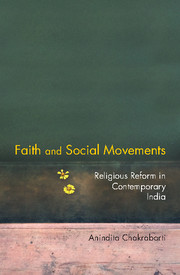Book contents
- Frontmatter
- Contents
- List of Figures
- Preface
- Acknowledgments
- Introduction: Dissent, Religion and Civil Society
- Part I Svadhyaya Ethics and the Spirit of Voluntarism
- 1 Theologies of Self-reform: What Transforms the Cross?
- 2 Praxis of an Emergent Congregation: Metaphysics of Reform and Rebirth
- 3 The Structure of Lokasaṃgraha: Volunteers, Networks and Training
- 4 Succession, Routinization of Charisma and Judicial Religion
- Part II The Tablighi Jamaat's Call for Self-reform
- Conclusion: Religion, Movements and Secularity
- Glossary
- Bibliography
- Index
4 - Succession, Routinization of Charisma and Judicial Religion
from Part I - Svadhyaya Ethics and the Spirit of Voluntarism
Published online by Cambridge University Press: 28 February 2018
- Frontmatter
- Contents
- List of Figures
- Preface
- Acknowledgments
- Introduction: Dissent, Religion and Civil Society
- Part I Svadhyaya Ethics and the Spirit of Voluntarism
- 1 Theologies of Self-reform: What Transforms the Cross?
- 2 Praxis of an Emergent Congregation: Metaphysics of Reform and Rebirth
- 3 The Structure of Lokasaṃgraha: Volunteers, Networks and Training
- 4 Succession, Routinization of Charisma and Judicial Religion
- Part II The Tablighi Jamaat's Call for Self-reform
- Conclusion: Religion, Movements and Secularity
- Glossary
- Bibliography
- Index
Summary
The King is dead.
Long live the King!
(English proverb)When we began Svadhyaya, there was no question of inheritance because
there was nothing to inherit.
(Former senior Svadhyayi, July 2004, Mumbai)The discussion in Chapter 3 underscored how the success of Svadhyaya was due to a well-calibrated coordination between its central leadership in Mumbai and a network of committed activists in the cities, towns and villages of Gujarat. The crucial role of the local-level leadership in the movement needs to be understood not as an administrative or organizational category but as an ‘organic’ and moral leadership. In Chapter 2, I have discussed the concept of charisma as ‘cultivated’ grace that marked the relation between different levels of leadership. But how would these riches of lokasaṃgraha be carried forward from one generation to the next? This chapter explores the complex question of succession in the movement. The problem of succession is common to all institutions and organizations, be they social, religious, political or economic. As a religious movement grows in size and influence, it incorporates the entire range of worldly problems: policy, leadership and ambition, wealth and its use, distribution and control. It is at critical moments such as succession that the issue of power within the movement comes to the fore. Charisma, if it is true, cannot be ‘transferred’ or replicated and therefore ‘routinization of charisma’ is always a contested affair as the followers take recourse to many ways to continue what the charismatic leader had initiated. The more important the office, the more vexed is the question of succession. I shall first discuss how the question of transmitting a charismatic vision beyond a generation in religious movements has always swayed along the axis of kinship and the sangha. The unfolding of the dispute in Svadhyaya shows how dissent within the movement took its root over the question of a suitable successor. When the issue could not be resolved by the group and reached the court of law, the legal–bureaucratic aspect of religion came to the forefront.
- Type
- Chapter
- Information
- Faith and Social MovementsReligious Reform in Contemporary India, pp. 112 - 132Publisher: Cambridge University PressPrint publication year: 2017



